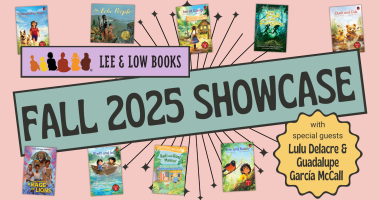Jaclyn DeForge, our Resident Literacy Expert, began her career teaching first and second grade in the South Bronx, and went on to become a literacy coach and earn her Masters of Science in Teaching. In her column she offers teaching and literacy tips for educators.
Last Monday, my post on close reading in the second grade classroom inspired some great discussion in the comments section from Lee & Low authors Sally (Derby) Miller (author of My Steps) and Edith Hope Fine (author of our mentor text for the post, Under the Lemon Moon). Click here to read both my post and their thoughts in full.
Something Sally Miller brought up in her comment really stuck with me. On what she imagines a close reading experience to be in a lower elementary classroom:
“We are talking about very young children–say ages five to eight–who have just heard or read a short, illustrated text. Some of them liked it, some of them loved it, and some of them waited patiently for a change in activity so that they could move around the classroom instead of being required to sit and absorb the story. Very well, it has ever been thus in public schools. But now…now they are expected to stay focused on the story, to decide why the author wrote it the way he did, why he used certain words, why he chose to set the story in, say, another country instead of this one. It’s not a story any more, it’s a lesson.”
 The adoption of the new Common Core Standards has certainly not come without controversy. One of the purposes of the new standards, from what I understand, is to begin to address large gaps in reading comprehension and performance that we’re seeing in high schools across the country. SAT scores for the high school class of 2012 indicated that a whopping 57% (!!!) of test takers “did not score high enough to indicate likely success in college, according to the College Board.” (Layton, Lyndsey and Brown, Emma; Washington Post; Sept. 24, 2012).
The adoption of the new Common Core Standards has certainly not come without controversy. One of the purposes of the new standards, from what I understand, is to begin to address large gaps in reading comprehension and performance that we’re seeing in high schools across the country. SAT scores for the high school class of 2012 indicated that a whopping 57% (!!!) of test takers “did not score high enough to indicate likely success in college, according to the College Board.” (Layton, Lyndsey and Brown, Emma; Washington Post; Sept. 24, 2012).
Unfortunately, one thing the SAT and comparable tests do not measure is the “joy factor,” how much students enjoy reading in and out of the classroom and how that affects their test scores (I think it’s safe to assume, though, that there’s probably at least correlative data out their to suggest that students who like reading are more likely to do well on reading assessments, but I don’t know that love of reading alone is enough to support a causal relationship). But the data from the SAT and studies done by the Alliance for Excellent Education (like the one that states “8.7 million secondary students—one in four—are unable to read and comprehend the materials in their textbooks”) do show us what lack of in-depth vocabulary acquisition and reading comprehension instruction can do, which is hold our students back in the long term.
The Read Aloud in lower elementary school, in addition to being a time to introduce spectacular literature and fascinating nonfiction and to foster a love of reading in our students, must also be instructional time. Personally, I haven’t found love of reading and rigorous reading instruction to be mutually exclusive. One way to ensure that the joy factor isn’t missing from the reading block while also ensuring that our children are being challenged to develop their critical thinking skills is through the use of anchor texts. Back in my second grade classroom, I chose a set of about 15 titles (the anchor texts) that we read and reread (and reread again and again) over the course of the year. The first couple readings looked very much like the read aloud Edith Hope Fine described (bold italics added for emphasis):
“We say the first line together (“Deep in the night Rosalinda heard noises”), moving our hands to the rhythm of the words. We brawk and flap like chickens. “Three times only,” I say, brawking, and 98% of the time we get just three brawks when we do in en masse)…My approach also depends on whether the group has heard or read the book already . . . We talk about how Rene King Moreno made the dragonflies and butterflies huge to match the magical tone of the tale, then we make butterflies with our hands…This active word play keeps even the wiggliest of listeners engaged. At this point they’ve sat on their bottoms long enough, so they become growing lemon trees, standing slowly without a word (after all, trees don’t talk) and waving their arms slowly like branches, then sitting down for a few more minutes to talk about the book and ask questions. Skilled teachers know how to get to the heart of the story and those all-important higher levels of thinking while keeping the experience light, intriguing, joyful. Discussion of the book, exploration of the ideas may take place over over several readings. Pulling students into books—letting young readers dive deep and wide—is one of the warmest, most important, and most rewarding parts of teaching.”
 Over the next several months, by the third and fourth (and subsequent) readings, we revisited our favorite parts of the reading experience (like Fine’s example above) and we’d practiced more reading strategies, so students were ready to take their understanding of the story to the next level. Experience varies from classroom to classroom, but I found that my students loved revisiting old texts (one of my then second graders, Asia, once said rereading a book was like visiting an old friend). They were given free reign of the library for their independent reading, where many students chose to take old favorite books home alongside new titles and books on their reading level. The ability to choose their independent reading also served to foster a love of literature and nonfiction, as students could select books by authors they loved or on topics they were interested in.
Over the next several months, by the third and fourth (and subsequent) readings, we revisited our favorite parts of the reading experience (like Fine’s example above) and we’d practiced more reading strategies, so students were ready to take their understanding of the story to the next level. Experience varies from classroom to classroom, but I found that my students loved revisiting old texts (one of my then second graders, Asia, once said rereading a book was like visiting an old friend). They were given free reign of the library for their independent reading, where many students chose to take old favorite books home alongside new titles and books on their reading level. The ability to choose their independent reading also served to foster a love of literature and nonfiction, as students could select books by authors they loved or on topics they were interested in.
I would never attempt to teach each and every one of the questions I outlined in my previous posts at one time in one sitting. Sally Miller is right to conclude that type of lesson would absolutely be overwhelming for young students! When I sat down to create the list of questions in my previous posts, it was with the intention that teachers would pick and choose which questions they want to focus on based on where their students are and what they’re struggling with (and I will absolutely make that clearer in my next post!). The key to student engagement with material is teaching right at the intersection of mastery and challenge, and introducing too much too quickly without the proper scaffolding definitely causes students to tune out! When executing close reading in the classroom, teachers should select and focus on a few questions at a time, or tackle all of the questions over several sittings.
For more on striking the balance between an engaging and rigorous reading block in the high school classroom, I suggest Kelly Gallagher’s awesome article entitled “Reversing Readicide.” I think many of her points can be applied to the elementary classroom as well.
Also, I wanted to pass along two great resources I received via email from one reader, a literacy expert working here in NYC:
- Implementing the Common Core State Standards: A Primer on “Close Reading of Text” by Sheila Brown and Kee Kappes
- Engaging the Adolescent Learner by Douglas Fisher and Nancy Frey
Educators: What do you do to keep instruction rigorous while fostering a love of reading in your students?









